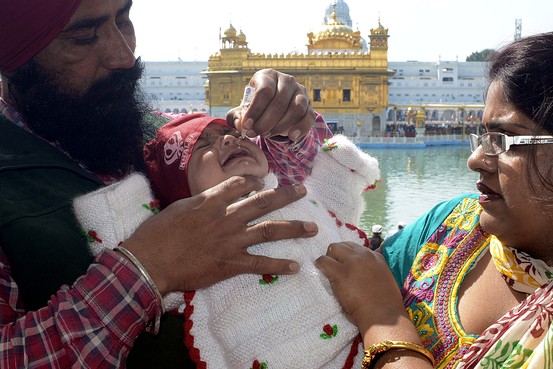WHAT NEXT AFTER POLIO IN INDIA’S HEALTH AGENDA?

In January, India celebrated three years without a single case of polio.
On March 27, the country will officially be certified polio-free.
That landmark achievement is now prompting the question ‘What next?’ On the campaign trail, leaders of both major national parties, Congress and the Bharatiya Janata Party, are urging action on even tougher health challenges, including the ultimate reform: universal health coverage for all citizens. Whoever wins the parliamentary election in May will inherit a mandate to bring India’s weak and fragmented health system into the 21st century.
The emergence of health as a premier political issue is a remarkable step forward for the country. The government spends just 1.2% of GDP on healthcare, the lowest of the group of emerging economies that includes Brazil, Russia, China and South Africa, known as the BRICS. As a result, India is saddled with a high burden of preventable disease – including measles, tetanus and rubella – that traps families and communities in poverty. The rapid rise in cardiovascular diseases, diabetes, cancers and other chronic disorders compounds the challenges faced by an under-resourced health system that is still grappling with tuberculosis, malaria, AIDS and high rates of maternal and child mortality.
While lifesaving medicines made in India are routinely exported to countries that provide them to citizens at no charge or low prices – earning India the nickname “pharmacy to the world” – access to these same medicines within India is severely limited. This forces many Indians, even the middle class, to forgo essential care, or make trade-offs between paying for care and paying for food, education or shelter.
Indian health officials have talked for years about instituting universal health coverage as a way to remove barriers to good health and expand access to quality, affordable care. The government’s five-year plan for 2012-2017 includes a goal of assuring “access to a defined essential range of medicines and treatment at an affordable price” so that no one faces a choice between financial stability and seeking healthcare.
But turning intention into action has been another matter. Health in India is traditionally a state concern – while the national government sets the general policy direction, each state has wide discretion in implementation. Too often, this decentralized responsibility has been used as an excuse to ignore health. India’s economic slowdown has also pushed health down the agenda, despite the well-proven links between good health and economic growth.
A few Indian states have taken a different path, however, experimenting with universal health coverage reforms that offer a model for the rest of the country. Tamil Nadu in the south is one such example. The provision of free or low-cost health services to the entire population has produced terrific results: 90 % of newborn deliveries are assisted by a skilled birth attendant, and more than 80% of children are fully immunized by the time they are one year old. Between 2000 and 2012, Tamil Nadu reduced its infant mortality rate by nearly two-thirds, compared to the national average reduction of just one-third over the same period.
So what did Tamil Nadu do right? It made investments in primary health care centers, well-trained health workers and fully-stocked pharmacies, and used public financing to make these services accessible to all, regardless of the ability to pay. Importantly, this commitment persisted across frequent changes in political leadership – in just over a decade, health has become a nonpartisan issue, prioritized regardless of who wields the power.
Tamil Nadu also increased its overall spending on health, recognizing that up-front investments in a functioning, equitable health system would save money over the long run. The rest of the country must follow suit. The 2012-2017 national plan recommends increasing public expenditure on health to at least 2.5 % of GDP by 2017, and at least 3% of GDP by 2022.
India is moving in the right direction on health but still finds itself playing catch-up. The nation has much to learn from its friends and neighbors. Encouragingly, India is a member of the Joint Learning Network for Universal Health Coverage, a consortium of nations sharing successes and lessons learned on the road to equitable health access for all.
Achieving universal health coverage in India will not be easy – but then again, neither was the elimination of polio. Success depends on smart planning, mobilization of entire communities and strong political leadership. No matter who wins in the next election, the health of India’s people must come out on top.
Source:
http://blogs.wsj.com/indiarealtime/2014/03/25/after-polio-whats-next-on-indias-health-agenda/Previous Post:





